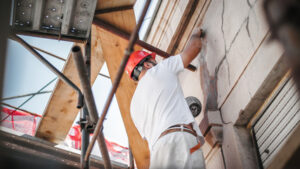Correct Preparation Is Essential For A Successful Concrete Repair
The correct preparation is essential for a successful concrete repair. Large overlays or patches can trap moisture and should be oriented correctly. Certain repair materials generate heat when they cure, which is unacceptably high. Another concern is shrinkage. Concrete repair materials should be compatible with the original material to avoid causing further damage. Incorrect preparation will compromise the appearance of the area. Below are tips for concrete repair. Use a high-quality products from Concrete Repair.

First, evaluate the condition of the existing concrete. Determining the cause of deterioration and determining the repair materials are critical. The evaluation process may include reviewing existing design documents and structural analysis of the structure in question. Non-destructive and destructive testing, chemical analysis, and corrosive activity evaluation may also be performed to determine a concrete repair material’s suitability for the situation. Once all of these factors are determined, the repair procedure can begin.
There are two types of concrete repair. Partial and full-depth repairs are common. In the former, the damaged concrete is removed and replaced with fresh concrete and reinforced steel. Partial-depth repairs include removing damaged concrete and cleaning the reinforced steel. Partial-depth repairs involve cutting around damaged concrete, but can also include cleaning and reinforcing steel. Using a mix of both types of concrete repairs is a better solution for small-scale repairs.
Regardless of the type of concrete repair material used, the process must be properly prepared to ensure that it lasts as long as possible. To start with, remove any crumbling areas before repairing the area. Use a heavy-duty trowel to break out small areas. Larger areas may require a sled and a cold chisel. The area must also be as dry as possible and free of debris before the repair begins.
If the crack is large enough, a cement-based product is the most effective choice. It mixes with water to create a stiff clay-like putty that can be forced into the cracks. A putty knife or trowel is helpful when applying quick-setting cement. For smaller cracks, an acrylic fortifier may be necessary. The fortifier slows down the cure time of the cement. In addition, a thin layer of acrylic paint may be necessary to avoid permanent damage.
Cracking or honeycombing concrete are obvious signs of damage. Concrete repair experts will be able to properly assess the extent of the problem and make a plan to solve the problem. These problems are often the result of incorrect design, stripping, or drying shrinkage. Regardless of the cause, the right solution is essential for preventing costly structural damage from becoming permanent. However, concrete cracks can return due to underlying problems and need to be replaced.
Another important characteristic to consider when selecting a concrete repair material is bond strength. The bond strength of concrete repair materials depends on their properties and the surface roughness of the concrete substrate. The bond strength of concrete repair materials was evaluated through a pull-off test conducted according to BS EN 1542 (1999). The substrate was treated with a 20 MPa compressive strength geopolymeric mortar. A circular hole was drilled through the geopolymeric mortar layer and metallic discs were then stuck to the geopolymeric mortar.
Chemical factors that cause concrete damage include changes in temperature, exposure to corrosive elements, and ground shifting. The physical factors are categorized into two main categories: mechanical and biological. Mechanical factors include overloading and construction faults. Exposure to extreme temperatures, and chemical factors such as microorganisms, salts, and leaching of cement paste from the concrete, lead to chemical deterioration of concrete. As a result, concrete repair requires careful evaluation and treatment.
Regular maintenance of concrete surfaces can prevent costly repairs from happening. A simple way to determine if the concrete needs repair is to see if stains or cracks are visible. In many cases, stains are easy to remove with simple washing. However, if the stain is more stubborn or old, a different cleaning method is required. For example, cleaning concrete with amyl acetate and acetone is necessary. Lastly, concrete repair is important for the aesthetics of a building.
Fortunately, there are several types of concrete repairs available for homeowners. If you need to repair a large area of concrete, reforming is necessary. To do this, remove the broken area down to the gravel fill. Digging a couple of inches below the surface will allow the new surface to be level with the surrounding concrete. Place form boards level with the new surface and the adjoining one. Make sure to use stakes at every four feet to help guide you in completing the project.
